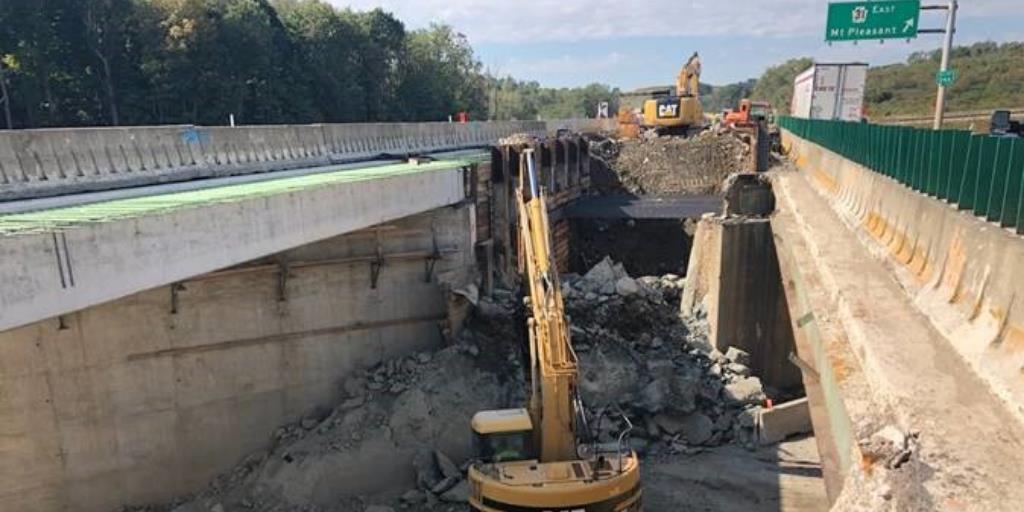
Successful highway and bridge projects depend on a high level of collaboration between PennDOT and its partners. Championed by the Pennsylvania State Transportation Innovation Council, the innovative Design-Build Traffic Control Plan (DBTCP) aims to improve project delivery by exploring ways to provide greater contractor flexibility in constructing a project.
Design-Build Traffic Control recently saw success on the Interstate 70 improvement project in PennDOT District 12. The new process allowed general contractor Golden Triangle Construction Company, to better use its experience and innovation to deliver a more efficient traffic control plan that saved time and money.
"By giving the contractor responsibility for developing the traffic control plan, PennDOT allowed us to take what we know and take our ideas and incorporate them into the plan we could construct and fit within our systems and methods," said Eric Klimas of Golden Triangle Construction Company.
He added that the project went well and the process moving forward will be even more streamlined and leave the door open to even more innovation. Delivering an exceptional traffic control plan "ensures construction can be expedited and carried out in a way that is safe for the contractor and the traveling public," Klimas said. 
The I-70 project involved improving the interstate in Westmoreland County from east of Interchange 49 at Smithton Borough to east of Interchange 51 in South Huntingdon Township. The work included rebuilding Interchange 51, replacing a bridge over Route 31, adding a 10-foot median and 12-foot shoulders and improving the sight distance for two horizontal curves. Additional improvements were also made to Routes 31 and 3061 and Smithton Pike.
The DBTCP allows the contractor and designer to work closely on the final design of the traffic control plan. The revised process allows for flexibility in selecting materials, construction methods, and available resources. Also, the revised process reduces the need for change orders because the construction team is responsible for the completeness and quality of the final traffic control plan. The construction team can explore cost savings, respond to schedule changes, and receive input from other members involved in the construction of the project.
"We used to provide a final traffic control plan," said Rachel D. Duda, P.E., assistant district executive for design in District 12. "If the contractor needed to change it, they had to go through a process that created work orders and required time for reviews and approvals."
With DBTCP, "we just do a conceptual plan, and they (contractors) have the ability to finalize it. That creates efficiencies," Duda said. "…There is a lot more flexibility to figure out materials and construction methods and available resources. It means savings in design and construction."
Duda leads the STIC's Design Technical Advisory Group that worked on the DBTCP innovation.
"It was a good partnering process," added Sean P. Sepe, P.E., PennDOT's project manager. "Overall, it was a good experience."
Lessons learned were applied to a subsequent I-70 project in the district. For example, according to Duda, the district found that providing conceptual cross sections at critical locations, such as grade separations, is beneficial to contractors, in addition to releasing the unofficial plans as early as possible.
"By releasing the unofficial plans early, including design build special provisions and maintenance and protection of traffic, or MPT, restrictions, allowed contractors to develop their own work zone traffic control (WZTC) plans and estimates," said Duda.
Duda added that by making improvements to the design build special provisions, the district was able to incorporate the improved special provisions into future projects with Design Build WZTC, resulting in considerably less questions during the advertisement phase of these newer projects.
"There were much fewer questions, and we a had a better transition," Sepe noted.

ABOUT THIS BLOG
Did you know PennDOT is directly responsible for nearly 40,000 miles of highway and roughly 25,000 bridges? We oversee programs and policies affecting highways, urban and rural public transportation, airports, railroads, ports and waterways, in addition to administering the state's more than 11 million vehicle registrations and 8.8 million driver's licenses.
So, how do we do what we do? And how can we help you travel in Pennsylvania — whether it be for business or leisure — in safe and enjoyable manner? Read PennDOT Way to learn more about the department, what we do, and how and why we do it.
TAGS
50-Year Anniversary, 511PA, Aggressive Driving, Airports, Autonomous Vehicles, Bicycles, Bridges, Child Safety, Community Relations, Construction, COVID-19, Distracted Driving, District 1, District 10, District 11, District 12, District 2, District 3, District 4, District 5, District 6, District 8, District 9, DOTcom, Driver and Vehicle Services, Emergency Responders, Employment, Equity, FAQ Friday, Human Trafficking, Impaired Driving, Innovations, Live Free Ride Alive, Maintenance Monday, Motorcycles, Older Drivers, PA Motorcycle Safety Program, Pedestrians, PennDOT Connects, Ports, Public Transit, Railroads, REAL ID, Road MaP, Roadside Beautification, Rural Roads, Safety, School Buses, Seat Belts, State Transportation Innovation Council (STIC), Sustainability, Teen Drivers, Throwback Thursday, Transportation Funding, Travel in PA, Welcome Centers, Winter, Work Smart, Work Zone, Yellow Dot
LATEST POSTS
PennDOT Continues Sharing, Updating Resources for Local Governments to Pursue Bipartisan Infrastructure Law Funding Opportunities
Norwin High School Wins 2024 ‘Innovations Challenge’
Demo Complete: I-95 CAP Project in Center City Philadelphia
PennDOT Archeologist Connects Past, Present, and Future
Lehigh Valley DUI, Highway Safety Task Force Hosts Law Enforcement Seminar
ARCHIVES
2024
2023
2022
2021
2020
2019
2018
2017

